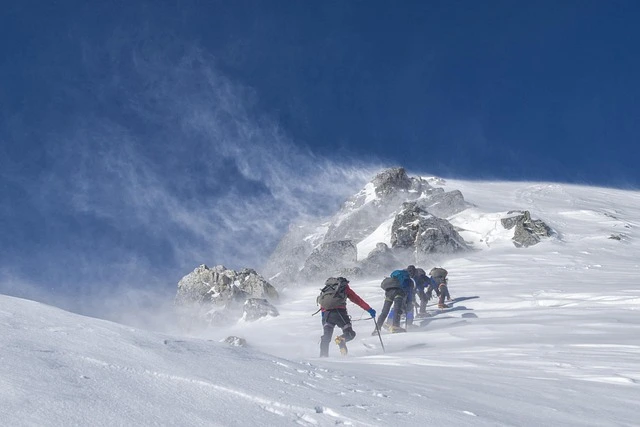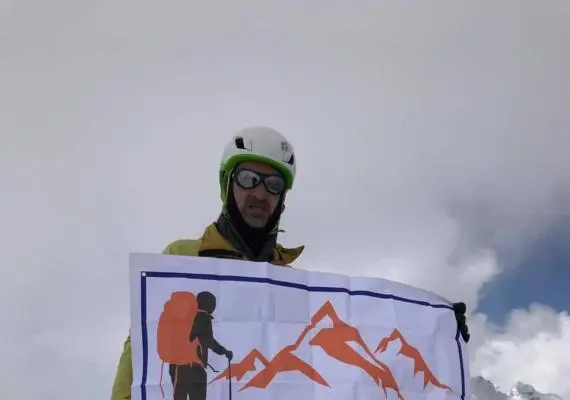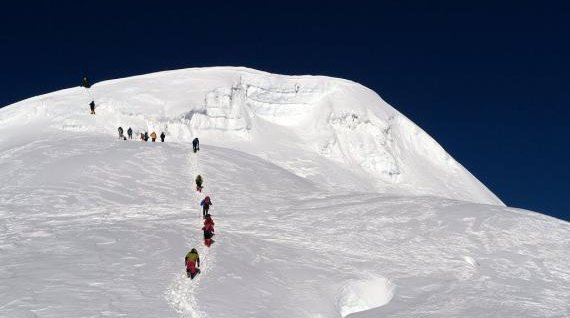Planning your Lobuche Peak climbing adventure? This comprehensive guide breaks down the exact costs and detailed itinerary for conquering this stunning 6,119-meter trekking peak. At $2,500 for our complete 19-day package, you'll discover why Lobuche East offers exceptional value for Himalayan peak climbing.
Trip Highlights
- Summit Lobuche East Peak (6,119m) - one of Nepal's most accessible trekking peaks
- Experience the classic Everest Base Camp trek route through Sherpa villages
- Acclimatize properly with strategic rest days at key altitudes
- Cross the Khumbu Glacier and navigate fixed ropes to the summit
- Witness sunrise views of Everest, Lhotse, Nuptse, and Ama Dablam
- Stay in traditional tea houses and high-altitude camps
- Trek through Sagarmatha National Park, a UNESCO World Heritage site
- Professional climbing guide and porter support included
- All permits, meals, and accommodations covered in package price
Short 19-Day Itinerary
- Day 1: Fly Kathmandu to Lukla (2,840m), trek to Phakding (2,610m)
- Day 2: Trek to Namche Bazaar (3,440m) - gateway to Everest region
- Day 3: Acclimatization day in Namche - explore local markets
- Day 4: Trek to Tengboche (3,860m) - visit famous monastery
- Day 5: Trek to Dingboche (4,410m)
- Day 6: Acclimatization day - hike to Nagarjun Hill (5,100m)
- Day 7: Trek to Lobuche village (4,940m)
- Day 8: Trek to Everest Base Camp (5,364m), return to Gorak Shep
- Day 9: Sunrise at Kala Patthar (5,545m), trek to Lobuche
- Day 10: Trek to Lobuche High Camp (5,400m)
- Day 11: Summit Lobuche East (6,119m), return to High Camp
- Day 12: Contingency day for weather
- Day 13: Descend to Pangboche (3,985m)
- Day 14: Trek to Namche Bazaar
- Day 15: Trek to Lukla
- Day 16: Fly to Kathmandu
- Days 17-19: Buffer days for flight delays
Permits & Fees For Lobuche Peak Climbing
Climbing Lobuche Peak requires several permits. Here's the complete breakdown:
- NMA Trekking Peak Permit Cost:
- Spring season (March-May): $250 per person
- Autumn season (September-November): $125 per person
- Summer/Winter season: $70 per person
- Sagarmatha National Park Fee: NPR 3,000 (approximately $23 for foreigners)
- TIMS Card Cost: NPR 2,000 (approximately $15)
- Local Area Permit: NPR 2,000 (required for Khumbu region)
- Garbage Deposit: $500 (refundable upon proper waste disposal)
- Liaison Officer Fee: Not required for trekking peaks under 6,500m
Nepal requires all climbers to hire a licensed guide for peak climbing. Solo climbing isn't permitted on Lobuche Peak. Your guide must be certified by the Nepal Mountaineering Association (NMA). This requirement ensures safety standards and supports local employment in the Khumbu region.
The permit process typically takes 2-3 days in Kathmandu. Your trekking agency handles all paperwork, but you'll need to provide passport copies and photos. The NMA trekking peak permit for Lobuche is valid for one month from the issue date, allowing flexibility for weather delays.
Cost Breakdown For Lobuche Peak Climbing
Our $2,500 Lobuche Peak climbing package offers transparent pricing. Here's exactly where your money goes:
International Flights: Not included Domestic Flights (Kathmandu-Lukla-Kathmandu): $380 Permits & Fees: $385-500 (depending on season) Professional Climbing Guide: $600 Assistant Guide: $300 Porter Services: $400 Accommodation (tea houses & camping): $380 All Meals During Trek: $450 Climbing Equipment Rental: $150 Insurance for Staff: $85 Agency Service Charge: $200-315
Many competitors charge $2,200-3,500 for similar packages. Our price sits competitively in the middle while offering superior service. Budget operators might cut corners on safety equipment or guide qualifications. Premium operators often add unnecessary luxury touches that don't enhance the climbing experience.
Additional costs to budget:
- International airfare
- Nepal visa ($50 for 30 days)
- Travel insurance with high-altitude coverage
- Personal gear not included in rental
- Tips for guides and porters ($150-200 recommended)
- Extra nights in Kathmandu
- Personal expenses and snacks
The Kathmandu to Lukla flight deserves special mention. These Twin Otter flights operate weather-permitting only. During peak season, delays are common. That's why we include buffer days. Some climbers choose helicopter transport ($500 per person) for reliability, though weather affects helicopters too.
Accommodation costs vary along the route. Lower elevations offer comfortable tea houses with private rooms. Above 4,000m, expect basic dormitories. At Lobuche High Camp, we provide quality mountain tents. All accommodations include blankets, but bringing your own sleeping bag ensures warmth and hygiene.
Meal costs increase with altitude. A dal bhat (traditional Nepali meal) costs NPR 400 in Namche but NPR 800 in Lobuche village. Our package includes three meals daily, with variety decreasing at altitude. Pack energy bars and comfort snacks from Kathmandu.
Best Season & Difficulty
Optimal Climbing Windows
Spring Season (March-May) represents the premier climbing window for Lobuche Peak. Stable high-pressure systems dominate, creating ideal summit conditions. Daytime temperatures at base camp hover around 5-10°C, though summit temperatures still plunge to -20°C. The spring Lobuche Peak permit cost of $250 reflects high demand, but success rates justify the expense.
Spring advantages include:
- Stable weather patterns lasting 3-5 days
- Warmer overnight temperatures at altitude
- Less wind than autumn season
- Rhododendrons blooming below treeline
- Everest expedition activity adding excitement
Spring challenges:
- Crowded trails and tea houses
- Higher permit and flight costs
- Occasional late-season storms in May
- Dust on lower trails before monsoon
Autumn Season (September-November) offers Nepal's clearest mountain views. Post-monsoon rains wash dust from the atmosphere, creating spectacular visibility. The autumn Lobuche permit cost drops to $125, providing excellent value. October typically delivers the most stable conditions.
Autumn benefits:
- Crystal-clear mountain views
- Stable weather after the monsoon ends
- Festivals like Dashain and Tihar
- Lower permit costs
- Less crowded than spring
Autumn considerations:
- Colder temperatures than spring
- Shorter daylight hours
- Occasional early winter storms in November
- Flights more weather-dependent
Summer/Winter Seasons challenge even experienced climbers. The $70 permit reflects minimal demand. Summer brings monsoon clouds and rain, making summit views rare. Winter delivers brutal cold and deep snow, though dedicated climbers find empty trails and pristine conditions.
Understanding Lobuche's Difficulty
Lobuche East Peak's classification as a "trekking peak" by the Nepal Mountaineering Association indicates accessibility for fit trekkers with basic mountaineering skills. This designation separates it from expedition peaks requiring extensive technical expertise. However, "trekking peak" doesn't mean easy - respect for the mountain remains essential.
The summit route involves several distinct sections:
Lobuche Base Camp to High Camp (4,940m to 5,400m): This initial climb follows a rocky trail through moraine. The path isn't technical but requires careful footing. Most groups take 3-4 hours, allowing time for load distribution and acclimatization. High Camp sits on a rocky ledge with spectacular views.
High Camp to Glacier (5,400m to 5,600m): Pre-dawn departure means navigating by headlamp. The rocky scramble requires handholds in places. Fixed ropes begin where the glacier meets rock. Crampons go on here - a critical transition point requiring care.
Glacier Section (5,600m to 5,900m): The glacier initially presents moderate angles around 30 degrees. Crevasses exist but remain obvious in good visibility. The route steepens progressively. Fixed ropes provide security, though confident climbers might not need them continuously.
Summit Pyramid (5,900m to 6,119m): The final 200 meters present Lobuche's greatest challenge. Slopes approach 45 degrees. Fixed ropes become essential. The false summit at 6,000m tests mental strength - the true summit requires another 30-45 minutes. Snow conditions vary from firm névé to deep powder.
Physical fitness matters more than technical skill. If you can hike 6-8 hours daily carrying 10-15kg at sea level, you can train for Lobuche. Stair climbing with weighted packs provides excellent preparation. Previous altitude experience helps but isn't mandatory with proper acclimatization.
Lobuche East versus Lobuche West presents an important distinction. While only 26 meters separates their heights, Lobuche West demands technical rock climbing skills and expedition permits costing $400-600. West's exposed rock ridges and verglas (thin ice on rock) place it beyond most trekking peak climbers' abilities.
Gear & Preparation
Essential Climbing Equipment
Success on Lobuche Peak depends heavily on proper equipment. Quality gear ensures safety, comfort, and summit success. Here's comprehensive guidance on what you need:
Provided by climbing company:
- Dynamic climbing rope (50m x 9mm typical)
- Ice screws and snow stakes for protection
- Group first aid kit with altitude medications
- Emergency oxygen and mask
- High-altitude tents (North Face or Mountain Hardwear)
- Cooking equipment and fuel
- Fixed rope for summit sections
- Emergency communication devices
Personal gear to bring/rent:
Mountaineering boots form your most critical equipment. Insulated, crampon-compatible boots rated to -30°C prevent frostbite. Popular models include La Sportiva G2 SM or Scarpa 6000. Ensure proper fit with thick socks. Break in boots before departure. Rental boots in Kathmandu cost $5-8 per day but fit remains uncertain.
Crampons must match your boots perfectly. Twelve-point crampons with horizontal front points work best for Lobuche's mixed terrain. Steel provides durability over aluminum. Anti-balling plates prevent snow buildup. Practice fitting crampons with gloves before summit day.
Ice axe selection depends on height. A 60-70cm general mountaineering axe suits most climbers. Straight shaft models like Petzl Glacier suffice for Lobuche's moderate terrain. Leash prevents loss but modern practice often omits it.
Climbing helmet protects against falling ice, particularly in the gully sections. Lightweight models like Petzl Sirocco minimize neck strain during long summit days. Ensure compatibility with headlamp attachment.
Harness and carabiners should prioritize lightweight alpine designs. Adjustable leg loops accommodate clothing layers. Bring 4-6 carabiners including two locking models. A prusik loop provides backup ascender capability.
Down jacket rated to -20°C minimum keeps you warm during pre-dawn starts and summit winds. 800-fill down provides the best warmth-to-weight ratio. Hood compatibility with helmet improves functionality.
Sleeping bag selection impacts rest quality throughout the trek. Four-season bags rated to -20°C ensure warmth at High Camp. Down offers superior packability over synthetic. Rental bags in Kathmandu vary in quality - inspect carefully.
Clothing Layer System
Mountain weather demands versatile clothing systems. Here's a detailed breakdown:
Base layers: Merino wool or synthetic materials wick moisture. Bring two sets - one for trekking, one reserved for summit day. Avoid cotton entirely.
Insulation layers:
- Lightweight fleece or synthetic jacket for active use
- Medium-weight insulated jacket for rest stops
- Down jacket for extreme cold (covered above)
Shell layers:
- Waterproof/breathable jacket with hood
- Full-zip pants allow easy on/off with boots
- Materials like Gore-Tex or eVent perform best
Extremities:
- Liner gloves for dexterity
- Insulated gloves for moderate cold
- Expedition mittens for summit day
- Sun hat with neck protection
- Warm beanie fitting under helmet
- Buff or balaclava for face protection
Feet:
- Liner socks prevent blisters
- Medium-weight hiking socks (3-4 pairs)
- Thick mountaineering socks (2 pairs)
- Gaiters keep snow out of boots
Gear Rental in Kathmandu
Thamel district houses dozens of gear rental shops. Quality varies significantly. Established shops like Shona's Alpine Rental or The North Face offer reliable equipment. Inspect every item carefully:
- Check zippers function smoothly
- Examine crampon points for damage
- Ensure boots show minimal wear
- Test headlamp brightness and battery life
- Verify sleeping bag warmth rating
Typical rental prices in Kathmandu:
- Complete climbing set: $15-25 per day
- Down jacket: $2-3 per day
- Sleeping bag: $2-3 per day
- Boots: $3-4 per day
- Crampons: $2-3 per day
- Ice axe: $2-3 per day
Book during peak season requires advance reservation. Some shops require deposit equal to gear value. Photograph rental items to document condition. Gear rental saves significant luggage weight and purchase cost for occasional climbers.
Physical and Mental Preparation
Summit success depends equally on physical fitness and mental resilience. Begin training 3-4 months before departure:
Cardiovascular training builds the aerobic base essential for altitude performance. Mix long-duration and high-intensity workouts:
- Long hikes with elevation gain (4-6 hours)
- Running or cycling for aerobic fitness
- Stair climbing with weighted pack
- Swimming for low-impact endurance
Strength training prevents injury and improves climbing efficiency:
- Squats and lunges for leg power
- Step-ups mimicking climbing motion
- Core exercises for balance
- Upper body work for using trekking poles
Altitude preparation where possible:
- Hike high peaks in your area
- Consider altitude tent rental
- Practice yoga for breathing efficiency
- Learn pressure breathing techniques
Mental preparation often determines summit success. Visualize challenging sections. Develop mantras for difficult moments. Understand that discomfort is temporary. The false summit tests everyone - prepare for this psychological challenge.
Optional Add-Ons and Extensions
Everest Base Camp & Kala Patthar Integration
Our standard Lobuche Peak itinerary wisely includes both Everest Base Camp and Kala Patthar. These aren't mere add-ons but essential acclimatization components. The trek to Everest Base Camp on Day 8 provides crucial altitude exposure while fulfilling many trekkers' dreams.
The EBC experience offers:
- Photo opportunities at the famous boulder
- Khumbu Icefall views (though distant)
- Mingling with Everest expedition teams (in season)
- Achievement of reaching 5,364m elevation
- Mental confidence boost before summit attempt
Kala Patthar sunrise hike on Day 9 serves multiple purposes. The 5,545m viewpoint provides the region's best Everest views - the summit, North Face, and Southwest Face appear in full glory. This altitude push also stimulates red blood cell production, improving your body's oxygen-carrying capacity for summit day.
The pre-dawn start mimics summit day timing. You'll test clothing layers, practice with headlamp navigation, and gauge your altitude performance. Many climbers report Kala Patthar feeling harder than Lobuche summit due to timing in the acclimatization schedule.
Three Passes Trek Extension
For ultimate Khumbu region exploration, consider adding the Three Passes traverse. This challenging extension adds 7-10 days but rewards with solitude and scenery:
Kongma La Pass (5,535m): Technical sections require careful route-finding. The glacier crossing adds mountaineering elements. Views encompass the entire Everest massif.
Cho La Pass (5,420m): The most challenging pass features a glacier traverse. Fixed ropes sometimes assist in icy conditions. The descent to Gokyo valley reveals turquoise lakes.
Renjo La Pass (5,360m): The easiest pass still demands respect. Panoramic views include Everest, Cho Oyu, and the Gokyo lakes. The western approach offers solitude.
Adding Three Passes costs $700-900 extra, including:
- Additional guide and porter days
- Extra food and accommodation
- Extended permits
- Possible gear rental extensions
This option works best for experienced trekkers. The continuous high altitude and remote terrain increase risk. Most combine it after Lobuche summit, utilizing peak fitness and acclimatization.
Island Peak Combination
Ambitious climbers often inquire about adding Island Peak (6,189m) to their itinerary. While possible, this combination requires careful consideration:
Advantages of combining peaks:
- Maximizes permit and flight costs
- Builds technical skills progressively
- Provides two summit experiences
- Utilizes peak acclimatization
Challenges to consider:
- Extended time at altitude increases risk
- Physical and mental fatigue accumulates
- Weather windows might not align
- Additional cost of $800-1,000
Island Peak requires crossing aluminum ladders over crevasses - a skill not needed on Lobuche. The summit ridge exposes climbers to significant drops. Technical difficulty remains similar, but psychological demands increase.
Most successful two-peak climbers space summits 3-4 days apart. This allows recovery while maintaining acclimatization. Climbing Island Peak first provides skills practice for Lobuche's longer summit day.
Helicopter Options
Modern helicopter services transform Khumbu logistics. Several options enhance flexibility:
Lukla to Kathmandu: $500-600 per person saves two days versus flying. Weather delays affect helicopters less than fixed-wing aircraft. Book through established companies like Summit Helicopters or Fishtail Air.
Emergency evacuation insurance: Essential coverage costs $100-200. Helicopter rescue from high altitude can exceed $10,000. Verify your insurance covers 6,000m+ elevation.
Scenic flights: $300-400 per person for Everest viewing flights from Lukla or Gokyo. These one-hour experiences provide photography opportunities impossible from ground level.
Cultural Extensions
Consider adding cultural experiences to your climbing adventure:
Tengboche Monastery Festival: If traveling during Mani Rimdu festival (October/November), allocate extra time. Masked dances and Buddhist ceremonies provide incredible cultural immersion.
Sherpa Heritage Sites: Khumjung village houses a supposed Yeti scalp. The Hillary School demonstrates ongoing development projects. These visits require just half-day detours.
Namche Museums: The Sherpa Culture Museum and Everest Photo Gallery merit visits during acclimatization days. Entry fees support local development.
Conclusion
Lobuche Peak climbing combines accessible mountaineering with stunning Himalayan scenery at an honest price point. Our comprehensive $2,500 package removes planning stress while ensuring safety through proper acclimatization and professional support. Whether seeking your first 6,000m summit or adding to your mountaineering resume, Lobuche East delivers an unforgettable experience worth every step of preparation.





